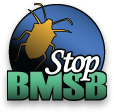Who Are the Native Natural Enemies of BMSB?
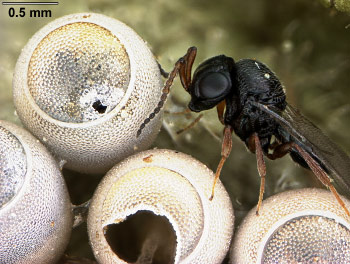 |
| Trissolcus euschisti on BMSB eggs. Photo by Elijah Talamas. |
By Christopher Gonzales, Jim Walgenbach, Arthur M. Agnello, Diane G. Alston, Nik Wiman
May 2017
The list of native natural enemies that attack brown marmorated stink bug (BMSB) includes other species of insects, spiders, and even some birds and mammals. For instance, birds to a certain extent, feed on BMSB adults[1], and small mammals such as rats may feed on BMSB eggs[2]. However, insects and spiders are largely recognized as the most important group of natural enemies of BMSB. These natural enemies can play an important role in reducing BMSB populations, and understanding how these different species behave in nature is key to developing successful biological control programs.
Arthropod natural enemies (insects, spiders and relatives) can be grouped into one of two general categories: parasite or predator. A parasite lives on or in another animal at the expense of the host. A parasitoid is an organism that lives on or in a host organism for a portion of its life and ultimately kills the host.[3] A predator is an animal that kills and consumes multiple prey during its lifetime. It’s debatable which group of insects—parasitoids or predators—have a greater impact on BMSB populations, as it depends on the habitat, but both are significant players. Learning to identify and protect these beneficial natural enemies can help them prosper around your farm, garden, or home.
Some of the most common insect parasitoids are small wasps that lay eggs in insect hosts, often in the eggs of other insects. The wasp larva feeds inside the host egg, halting its development. The parasitoid emerges from the nonviable host egg as an adult wasp. Egg-attacking parasitoids are the most common type of natural enemy of BMSB.
Much of what we know about parasitoids of BMSB comes from studies that use sentinel eggs. These are stink bug eggs, often obtained from laboratory-reared colonies, which are attached to a piece of index card or other material so that they can be placed in the field and retrieved at a later date to determine their fate.
These studies can tell us, for example, who are the important natural enemies of BMSB and how often parasitoids are successful in attacking BMSB. Success for the parasitoid might be defined as a live young insect emerging from an egg; from a human perspective, i.e., in terms of pest regulation, success is defined as a reduction in the BMSB reproductive potential.
In a two-year study in agricultural crops in the eastern US, predation, mainly by chewing predators, accounted for the majority of BMSB egg mortality.[4] Parasitism of BMSB eggs by native parasitoids was very low, ranging from only 1 to 4% of eggs. Predators, both those with chewing and sucking mouthparts ranged from about 9 to 22%. However, rates of parasitism and predation vary among habitats. For instance, parasitism rates as high as 10% have been observed in soybean fields, and in wooded habitats it can exceed 20%. Parasitism levels differ by habitat, in part, due to variation in parasitoid species occupying habitat niches.
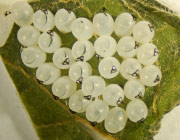 |
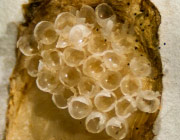 |
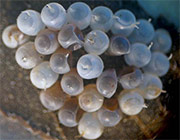 |
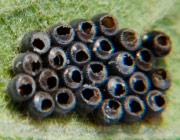 |
| Normal, hatched BMSB egg mass. Photo provided by Walgenbach Lab. | BMSB eggs showing damage from chewing predators. Photo by Rachel Suits. | BMSB eggs showing damage from sucking predators. Photo provided by Walgenbach Lab. | Parasitized BMSB eggs. Photo provided by Walgenbach Lab. |
It is noteworthy that U.S. scientists have recorded native parasitoids parasitizing > 50% of native stink bug eggs. This difference in successful attack of a native versus an introduced stink bug suggests that incompatibility may be at play. While the native parasitoids may not be decisive in the battle against BMSB, they help reduce populations.
Studies have also shown that spiders can play an important role in suppression of BMSB populations in human dwellings. When adult BMSB were introduced into the webs of various spiders, there was a greater than 50% chance of ensnarement and consumption. The most common spider families that snuffed out BMSB were Theridiidae, Pholcidae, and Agelenidae. Thus, while spiders will not catch every BMSB, they are an important contributing factor in reducing BMSB nuisance problems in homes.
There are many common native natural enemies of BMSB. Learning to identify them, and using integrated pest management (IPM) to protect them, can support the good guys that are active around your home, farm, or garden.
Parasitoids: Most Common Species
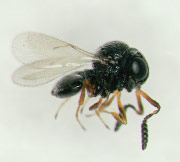 |
| Trissolcus brochymenae. Photo by Emily Ogburn. |
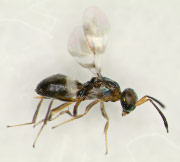 |
| Anastatus reduvii. Photo by Emily Ogburn. |
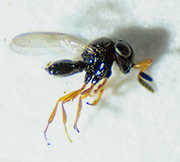 |
| Telenomus podisi. Photo by Emily Ogburn. |
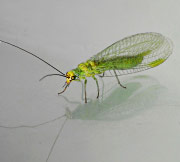 |
| Adult green lacewing (Chrysopidae). Photo by Joseph Berger, Bugwood.org. |
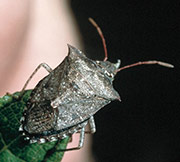 |
| Adult spined soldier bug (Podisus maculiventris). Photo by Kansas Department of Agriculture, Bugwood.org. |
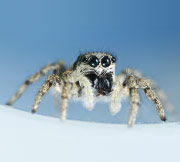 |
| Jumping spider (Salticidae). Photo by Joseph Berger, Bugwood.org. |
Family species
- Eupelmidae Anastatus reduvii
- Eupelmidae Anastatus mirabilis
- Eupelmidae Anastatus pearsalli
- Platygastridae Trissolcus brochymenae
- Platygastridae Trissolcus edessae
- Platygastridae Trissolcus euschisti
- Platygastridae Trissolcus utahensis
- Platygastridae Telenomus podisi
- Encyrtinae Ooencyrtus
Generalist Predators: Most Common Species[5]
- Neuroptera: Chrysopidae spp.
- Crabronidae: Astata bicolor
- Pentatomidae Podisus maculiventris
- Anthocoridae Orius insidiosus
- Lygaeidae Geocoris punctipes
- Lygaeidae Geocoris uliginosus
- coccinellids, ants, and grasshoppers
- Tettigonniidae (Atlanticus testaceous, Conocephalus strictus, and Orchelimum spp.)
- Carabidae (Harpalus spp.)
- Dermaptera (Forficulidae spp.)
- Gryllidae (Oecanthus spp.)
- Soldier beetle larvae (Cantharidae)
- Arachnids
- Theridiidae
- Pholcidae
- Agelenidae
- Salticidae
- Slugs (Gastropoda)
Notes:
[1] Accounts from homeowners received through the StopBMSB.org website describe birds feeding on BMSB.
[2] Chuck Ingels, in a presentation given at the June 2016 meeting of the Northeastern IPM Center BMSB Working Group, showed a picture of a rat eating BMSB eggs on a sentinel card. See slide 50 at http://neipmc.org/go/RkKD. Accessed on March 28, 2017.
[3] https://www.amentsoc.org/insects/glossary/terms/parasitoid. Accessed on March 28, 2017.
[4] Jones et al., 2014.
[5] Ogburn et al. (in press).
For more information:
Jones, A.L., D.E. Jennings, C.R.R. Hooks, and P.M. Shrewsbury. 2014. Sentinel eggs underestimate rates of parasitism of the exotic brown marmorated stink bug, Halyomorpha halys. Biol. Control 78:61–66; DOI: 10.1016/ Journal of Biocontrol, http://dx.doi.org/10.1016/j.biocontrol.2014.07.011
Morrison III, W.R., Mathews, C., Leskey, T.C., 2016. Frequency, intensity, and physical characteristics of predation by generalist predators of the brown marmorated stink bug (Hemiptera: Pentatomidae) eggs. Biol. Control 97:120–130.
Herlihy, M.V., E.J. Talamas, and D.C. Weber. 2016. Attack and success of native and exotic parasitoids of Halyomorpha halys in three Maryland habitats. PLoS ONE 11:e0150275 http://journals.plos.org/plosone/article?id=10.1371/journal.pone.0150275
Morrison, III, W.R., A.N. Bryant, B. Poling, N.F. Quinn, and T.C. Leskey. 2017. Predation of Halyomorpha halys (Hemiptera: Pentatomidae) from web-building spiders associated with anthropogenic dwellings. J. Insect Behav. 30:70–85.
Ogburn, E.C., R. Bessin, C. Dieckhoff, R. Dobson, M. Grieshop, K.A. Hoelmer, C. Mathews, J. Moore, A.L. Nielsen, K. Poley, J.M. Pote, M. Rogers, C. Welty, and J.F. Walgenbach. 2016. Natural enemy impact on eggs of the invasive brown marmorated stink bug, Halyomorpha halys (Stål) (Hemiptera: Pentatomidae), in organic agroecosystems: A regional assessment. Biol. Control 101:39–51., http://dx.doi.org/10.1016/j.biocontrol.2016.06.002
